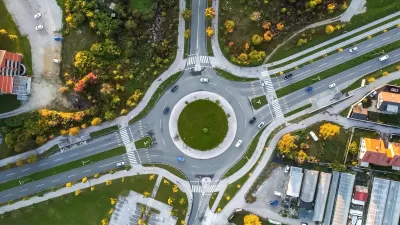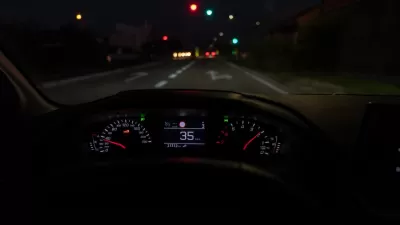Not usually regarded for their outside the box thinking, transportation engineers have nevertheless come up with some radical ideas for improving the flow of traffic and reducing the potential for collisions at busy intersections.
"Geometry tells us that the traditional four-way intersection is inherently dangerous," writes Emily Badger. "When you plot all of the potential points of conflict on a diagram – and transportation engineers actually do this – it turns out that vehicles have 32 distinct opportunities to collide into one another at the nexus of two two-lane roadways."
"With that geometry in mind, it becomes clear what we need in the holy grail of intersection design: a scheme that would eliminate left-hand turns while still enabling drivers to move in all four directions."
"John Sangster, a doctoral candidate at Virginia Tech and an alternative intersection enthusiast, introduced us to several and pointed us to some spellbinding animations from the Applied Technology and Traffic Analysis Program at the University of Maryland (many thanks to researchers there for sharing these clips)."
With such exotic names as the Jughandle, the Superstreet, and the Diverging Diamond, and even wilder traffic patterns, "these designs are not an easy sell."
"In theory – i.e., in conflict-point diagrams – these intersections should be safer than more traditional ones," says Badger. "But there are two caveats to that promise: Sangster is really talking about safer intersections for cars. Pedestrians and bikers aren’t figured into any of these models, and Sangster has yet to encounter designs that do a good job of incorporating them (or transit). There also isn’t much hard data on the safety of these designs because so few of them have been built (and even accurately modeling them on a computer can be tricky and expensive)."
FULL STORY: Could These Crazy Intersections Make Us Safer?

Alabama: Trump Terminates Settlements for Black Communities Harmed By Raw Sewage
Trump deemed the landmark civil rights agreement “illegal DEI and environmental justice policy.”

Planetizen Federal Action Tracker
A weekly monitor of how Trump’s orders and actions are impacting planners and planning in America.

The 120 Year Old Tiny Home Villages That Sheltered San Francisco’s Earthquake Refugees
More than a century ago, San Francisco mobilized to house thousands of residents displaced by the 1906 earthquake. Could their strategy offer a model for the present?

In Both Crashes and Crime, Public Transportation is Far Safer than Driving
Contrary to popular assumptions, public transportation has far lower crash and crime rates than automobile travel. For safer communities, improve and encourage transit travel.

Report: Zoning Reforms Should Complement Nashville’s Ambitious Transit Plan
Without reform, restrictive zoning codes will limit the impact of the city’s planned transit expansion and could exclude some of the residents who depend on transit the most.

Judge Orders Release of Frozen IRA, IIJA Funding
The decision is a victory for environmental groups who charged that freezing funds for critical infrastructure and disaster response programs caused “real and irreparable harm” to communities.
Urban Design for Planners 1: Software Tools
This six-course series explores essential urban design concepts using open source software and equips planners with the tools they need to participate fully in the urban design process.
Planning for Universal Design
Learn the tools for implementing Universal Design in planning regulations.
Clanton & Associates, Inc.
Jessamine County Fiscal Court
Institute for Housing and Urban Development Studies (IHS)
City of Grandview
Harvard GSD Executive Education
Toledo-Lucas County Plan Commissions
Salt Lake City
NYU Wagner Graduate School of Public Service





























